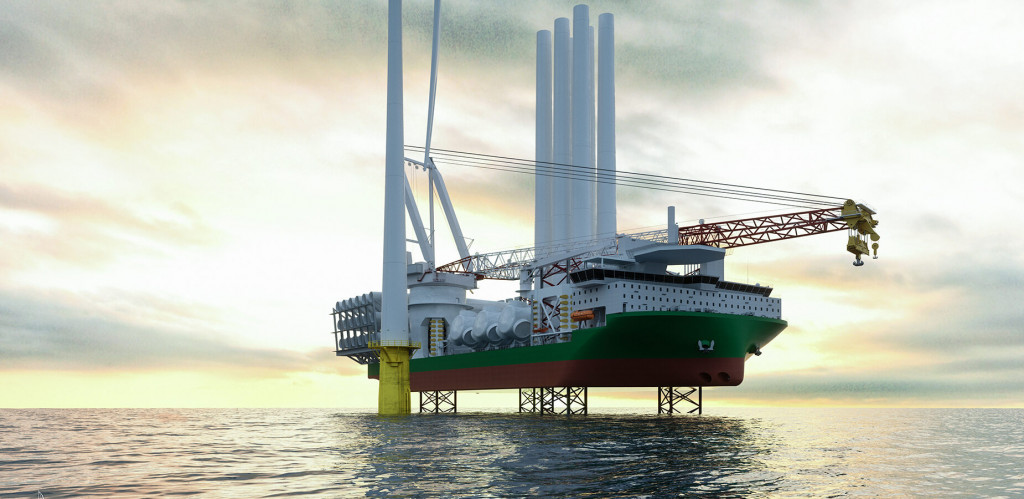Versatility and Customization take centre stage in the new Wind Turbine Installation Vessel (WTIV).
KNUD E. HANSEN continues to build on its portfolio of innovative designs and extensive experience in the offshore wind farm sector with a new platform: The ATLAS C-Class. Named after the Greek Titan tasked with holding up the sky and heavens above, this platform boasts unparalleled strength and durability.
With a jacking deadweight of 18,000 tonnes, 6,800 square metres of cargo deck area and a 3,000 tonne @ 37 metre crane, it is currently the only WTIV capable of carrying six of the new-generation 14-16 megawatt wind turbines, and at least five of the next generation 20+ megawatts turbines.
The jacking deadweight and crane capacity also enable the vessel to carry at least four of the extra-large monopile/transition piece foundations, which are required for the 14–16 megawatts turbines.

The impressive size and scale of this groundbreaking design is matched by its versatility and customizable features. The ATLAS C-Class is intended as a platform which will form the basis for further customization according to our clients’ objectives. Cranes, thrusters, generators and jacking systems can all be modified and selected based on manufacturer availability such that the vessel can be tailored to suit the individual needs of each client. This represents a significant departure from competitors that offer off-the-shelf products with little flexibility.
Details:
- Length Overall (excluding helideck) 170.00 metres
- Breadth, moulded 60.20 metres
- Depth to Main Deck 13.20 metres
- Draught, moulded @ 18,000 t deadweight 6.70 metres
- Speed @ 6.50 m draught incl. 10% s.m. 12.0 knots
In keeping with the objective of design versatility, the cargo deck incorporates uniform girder spacing in both longitudinal and transverse directions such that foundations for equipment and turbine parts can be standardized and installed in many different locations and orientations.
Energy savings and low emissions have been key drivers for the propulsion system. The vessel is powered by eight identical generators, each with 3,340 kilowatts of electrical power, which are arranged in two independent engine rooms. A DC grid system allows the engines to run at variable speed for maximum fuel efficiency. The DC grid system is coupled to a 4 megawatt battery pack for load leveling and peak shaving.
The batteries can supply “instant power”, which reduces the need for “spinning reserve power“ from generators running on standby (e.g. during DP operations), and they make it possible to recover approximately 60% of the energy that is used to jack the vessel to the operational height.
To further minimize power consumption, the vessel is equipped with some of the most efficient thruster units on the market. This includes four azimuthing stern thrusters, driven by highly efficient permanent- magnet motors and equipped with nozzles for maximum bollard pull. At the forward end, there are two tunnel thrusters and two retractable bow thrusters configured to maximize thrust. The platform is equipped with four 3-chorded trusswork legs which can support it in water depths up to 80 metres.
The spud cans are optimized for the lowest possible seabed penetration, and they are fitted with buoyancy boxes to reduce the draught in port, reduce the load on the seabed when the vessel is jacked up, and to help retract the legs out of muddy sea beds. The platform is elevated by a powerful high-speed electrical rack-andpinion jacking system designed for 5,000 load cycles.
This is significantly more than many of the competing designs and will ensure the leg racks will last the lifetime of the vessel. The optimal load balance of the vessel ensures the total jacking capacity of all four legs can by fully utilized in the fully loaded conditions.
The main deck of the accommodation block includes an operations center consisting of offices and meeting rooms as well as a hospital, day room, TV room, change room, and workshop. Above this is a large galley with spacious mess as well as ample provision rooms.
The three decks above include a total of 130 cabins for contractors, crew and officers. The top deck consists of a bridge with centerline and wing consoles and a large helicopter deck. Below the main deck is a gymnasium, cinema, TV room, games room, and sauna as well as a laundry room and store rooms.
Negotiations are currently ongoing with companies in the offshore wind sector to further develop the ATLAS C-Class platform based on their individual requirements. The ATLAS C-Class is the first in a series of planned WTIV platforms of varying sizes. One of those already under development is a smaller A-Class platform that can carry four 14 megawatt turbines and is equipped with a 1,600 tonne crane for clients who require a smaller variant to install wind turbines on pre-installed foundations.
The ATLAS C-Class has been developed completely inhouse, by the experienced staff of naval architects, marine engineers and designers at KNUD E. HANSEN who place the utmost importance on safety, efficiency and design ingenuity and have been doing so for over 80 years.

Follow us on social media: